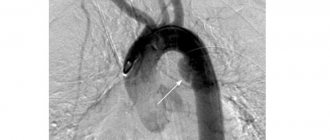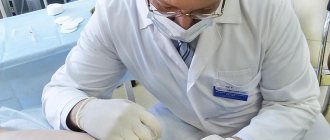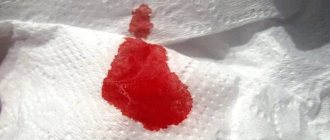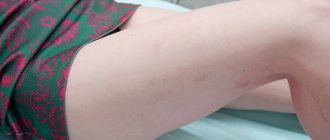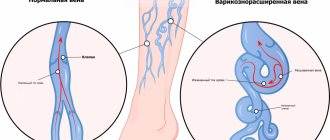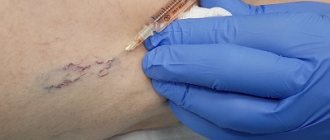28.06.2017
Diseases of the musculoskeletal system | Muscles and vessels of the limbs
Veins are vessels that carry blood from organs to the heart. There is no area on our body that is free from veins. They can be large and small, superficial and deep. The venous wall is very sensitive to everything that happens in the body at close and long distances. In turn, damage to the veins triggers a sad chain of disorders both in the tissues surrounding the vessel and in the body as a whole. For example, a seemingly harmless blood clot that heals the affected venous wall in the lower limb, breaking away from the site of formation and going on a journey, can lead to a catastrophe - the so-called. pulmonary embolism.
An inflammatory disease that affects the venous wall is of Greek origin and is called phlebitis.
Most often, the superficial and deep vessels of the lower extremities are affected (phlebitis of the lower extremities). Rarer ailments include:
- inflammatory damage to the veins of the brain (cerebral phlebitis);
- damage to the veins in the arm (phlebitis of the upper extremities);
- phlebitis of the penis;
- inflammation of the wall of the portal vein as a complication of pathological processes in the abdominal cavity (so-called pylephlebitis), etc.
Treatment methods for phlebitis of the veins on the arm
During the treatment of phlebitis of the veins in the arm, conservative methods are used:
Are you suffering from some kind of problem? Enter “Symptom” or “Name of the disease” into the form, press Enter and you will find out all the treatment for this problem or disease.
- Use of non-steroidal anti-inflammatory drugs;
- Antibacterial medications;
- Use of anticoagulants;
- Local measures - elastic bandage to restore blood flow.
If an infection is added to simple inflammation, then treatment consists of complex effects:
- Relief of the inflammatory focus;
- Prevention of spasms and hypertonicity of the walls;
- Increased venous blood flow;
- Qualitative improvement of blood viscosity;
- Fighting the formation of blood clots;
- Stabilization of the tone of the smooth muscles of the veins;
- Getting rid of puffiness and normalizing lymph circulation.
During the treatment of post-injection phlebitis of the veins in the arm, non-steroidal anti-inflammatory drugs are used, both orally and with the help of ointments.
Self-medication of phlebitis is fraught with complications for the patient, but poses a direct threat to his life.
If a focus of inflammation occurs on the arm after an injection or due to other reasons, it is necessary to seek specialized help for comprehensive treatment.
WHAT TO DO IN THE EVENT OF SWELLING IN YOUR HANDS?
To eliminate the problem, it is necessary to remove what provokes it. Actually, treatment for edema includes:
- supporting the lymphatic and moisture removal system with diuretics (involves simultaneous replenishment of potassium, since many such drugs contribute to its leaching, which is also dangerous);
- support of the vascular structure and prevention of skin defects using compression pads (selection of compression - strictly according to indications, individually with the participation of a physician);
- use of special ointments/gels;
- limiting the consumption of moisture-containing foods and water;
- refusal of alcohol-containing drinks/products;
- normalizing sleep/rest patterns will speed up the removal of edema;
- minimal load on hands.
Treatment of the underlying pathology should be based on the examination results.
Principles of post-injection phlebitis
When a medicine is injected into a vein, vasospasm occurs, which provokes favorable penetration of the infection. These actions can lead to inflammation in the vascular walls. Then blood circulation slows down a little, blood chemical parameters deteriorate, the walls of blood vessels become thinner, congestion forms, and infectious agents are found in the plasma. The likelihood of blood clots increases significantly, which is a serious complication of the disease - thrombophlebitis.
Phlebitis that occurs after an IV drip has several varieties:
- periphlebitis (when the subcutaneous tissues become inflamed along with the damaged vein);
- panphlebitis (all venous layers are damaged);
- endophlebitis (characterized by changes occurring inside the vein).
Arm pain
Gout
Arthritis
Rheumatism
Ulcer
28732 March 26
IMPORTANT!
The information in this section cannot be used for self-diagnosis and self-treatment.
In case of pain or other exacerbation of the disease, diagnostic tests should be prescribed only by the attending physician. To make a diagnosis and properly prescribe treatment, you should contact your doctor. Pain in the hand: causes of occurrence, what diseases it occurs with, diagnosis and treatment methods.
Definition
Pain can be accompanied by various pathological processes of the upper extremities - injuries, degenerative and inflammatory lesions, neurological syndromes. Pain in the arm can be one of the symptoms of diseases of the cardiovascular, respiratory and digestive systems of the body.
Types of hand pain
The variety of pain syndromes is determined not only by the complexity of the structure of the upper limbs, but also by the variety of functional loads. By its nature, the pain can be pulling, shooting, aching. It may bother you when there is strain on the arm, or it may occur at night and disturb sleep. In addition, irradiation (return) of pain to the arm is possible due to myocardial infarction, angina pectoris, colic, cholecystitis, and stomach ulcers.
Possible causes of arm pain
Arm pain can be physiological in nature and be caused by muscle fatigue
after heavy or unusual stress.
It occurs due to the accumulation of anaerobic metabolic products (lactate) in muscle tissue and resolves within two to three days.
After significant physical activity exceeding the muscle endurance threshold, delayed pain may occur (1–2 days after physical activity). Experts believe that they are caused by damage to muscle cells, their membranes, and connections between microfibrils. Such pain is usually long-lasting.
Injuries
– bruises, fractures, tendon sprains, muscle tears – are characterized by a sharp onset of pain and its intensity. Bruises and fractures are accompanied by severe pain, swelling, and hemorrhage from small or large vessels.
A sprain occurs when there is a sudden movement in the joint, lifting significant weights, or a fall with emphasis on the arm and is characterized by varying degrees of damage to the connective tissue fibers. This injury is accompanied by severe pain, swelling and limited mobility in the joint. Often, sprains occur in the area of the wrist and elbow joints after heavy loads or monotonous movements repeated many times.
Muscle ruptures and tears occur when overused. In addition to severe pain, there is hemorrhage in the area of injury and the inability to tense the muscle.
One of the largest groups of diseases that causes severe pain in the arm is tunnel syndromes
caused by compression and inflammation of the nerve in a narrow space (tunnel) formed by the muscles, ligaments and bones of the arm.
Additional factors that increase the risk of such inflammation are endocrine diseases (diabetes mellitus, hypothyroidism), impaired joint mobility due to arthritis or rheumatism, tumor formations in the nerve area (neurofibroma, schwannoma) or beyond it (hemangioma, lipoma). As a rule, tunnel syndromes develop during prolonged similar movements (when working at a computer, playing tennis) or injuries. This is facilitated by incorrect posture, scoliosis, and osteochondrosis.
Inflammation of tendons and joint ligaments
also develops with significant physical stress and injury, especially in cases where the tendons are attached to powerful muscles. Stretching and microtrauma at the attachment site are accompanied by aching, aching pain, which can become unbearable during physical activity. Inflammation leads to swelling and limited mobility in the joint. A common pathology of the hand is epicondylitis, in which inflammation affects the junction of the muscle and ligament of the elbow joint. In this case, the pain is localized in the elbow area and accompanies movement in the elbow, hand and fingers.
Joint damage due to arthritis
causes not only pain, but also stiffness of movement. The causes of such damage may be osteoarthritis, gout, etc.
In any case, all signs of inflammation are present: pain, swelling, local increase in temperature, redness of the skin in the projection of the joint, impaired movement in the joint.
Rheumatoid
arthritis
is characterized by damage to first the small and then large joints of the hand, which is accompanied by stiffness of movement in the morning. In addition to increased pain, joint deformation and limited mobility, the disease is also characterized by general manifestations of the disease - fatigue, sweating of the palms and feet, weight loss.
Deposition of uric acid salts (urates) in the joints is the main manifestation of gout
– leads to severe pain. Its intensity is so great that even simply touching the sore joints causes discomfort. The basis of the disease is a metabolic disorder.
With inflammation of the ulnar periarticular synovial bursa - bursitis
– pain occurs in the elbow and is accompanied by swelling of the joint. In addition to severe pain in the arm, which limits movement, local redness of the skin and increased temperature over the joint area may be observed.
Arm pain may be due to anterior scalene syndrome
and be accompanied by muscle spasm and compression of the nerves and vessels of the shoulder girdle. The disease may be based on degenerative changes in the vertebrae (osteochondrosis) of the cervical spine or trauma.
The patient is bothered by pain in the neck and shoulders, which prevents him from raising his arms up and to the sides, taking a deep breath, or tilting his head.
Osteochondrosis of the cervical spine and its complications
(disc protrusion, intervertebral hernia) cause pain in the arm due to pinching of the nerve that innervates it. In this case, not only sharp pain may occur, but also numbness of the hand and impaired sensitivity.
There is another reason that should always be kept in mind when pain in the arm occurs - myocardial infarction
. The patient feels severe pain behind the sternum, which can radiate to the neck, back and left arm. Such pain is not the only sign of this dangerous condition. As a rule, shortness of breath, cold sweat, and difficulty breathing are present.
Diagnosis and examinations for arm pain
To diagnose a condition that may be causing arm pain, it is necessary to consider how acute the pain is and the events that precede its onset. With severe injuries, making a diagnosis is usually not difficult, but to distinguish a bruise from a fracture, radiography is necessary.
In what cases is radical therapy required?
If drug therapy does not give positive results in the fight against phlebitis and the disease lasts for a long time, then surgical intervention would be a reasonable solution. This occurs when the affected area is inflamed, suppuration begins, blood clots form, and post-injection thrombophlebitis occurs.
The operation is performed in a hospital setting. Under local anesthesia, the patient has the resulting suppuration removed. The next day after surgery, it is recommended to wrap your arm with an elastic bandage and try not to disturb the limb.
- Phlebitis of the veins on the arm: treatment, causes, prevention
If phlebitis, especially its acute form, is not treated, a complication of the inflammation process (for example, blood poisoning) may occur and lead to death.
Symptoms of phlebitis
A typical inflammatory disease is characterized by a symptomatic “quartet”:
- pain;
- redness;
- edema;
- dysfunction.
Their intensity, duration and localization are determined by the location and nature of the vessel damage, and related factors.
If the superficial veins become inflamed, the disease manifests itself locally:
- Tension, density and swelling of tissues.
- Severe pain along the vessel.
- General hyperemia and increased skin temperature, bright stripes along the inflamed vein.
If the inflammation affects the deep veins, the symptoms change. Pain, tension and swelling remain, but instead of redness, the skin becomes milky white. Severe weakness appears in the affected limb (most often the deep veins of the lower limb are affected). Its cooling and weakening of pulsation may be observed (especially in complicated cases - thrombophlebitis).
The general condition of phlebitis of superficial and deep localization is characterized by:
- weakness and dizziness;
- high temperature;
- enlargement of nearby lymph nodes.
With phlebitis of the deep veins, these signs are more pronounced, and the malaise itself is longer lasting.
Similar symptoms are characteristic of both the acute form of phlebitis and during the period of exacerbation of a chronic disease.
Prolonged, intense and/or frequent inflammation of the veins (especially deep ones) is fraught with the involvement of neighboring tissues (including lymph nodes) in the inflammatory process with its subsequent generalization. And the development of such serious illnesses as:
- chronic venous stagnation and venous insufficiency;
- abscesses and phlegmons;
- gangrene;
- formation of ulcers;
- thrombosis;
- elephantiasis;
- pulmonary embolism.
Symptoms of the disease and the patient’s feelings
Phlebitis usually manifests itself within 24 hours after intravenous administration of the drug. The patient experiences redness at the site of the catheter or injection. It is removed with a catheter. However, the inflammatory process may continue to worsen and be accompanied by the following symptoms:
- due to the accumulation of blood at the injection site, the veins thicken and protrude outward;
- soft tissues thicken, which becomes noticeable upon palpation;
- severe pain occurs that radiates to the fingers;
- the hand swells (and several hours after the injection), severe swelling appears;
- blue discoloration of the affected area;
- The elbow and axillary lymph nodes are noticeably enlarged.
The patient's condition continues to deteriorate, the body temperature rises, and on the 3-4th day the limb stops bending and straightening at the elbow joint. If treatment is not started, the pathology will begin to spread to the adjacent vessel. Suppuration of the venous walls is also possible.
WHAT ARE HANDS SWELLING?
But edema cannot be ignored: although more often it is a way of adaptation of the body, such a defect can also indicate serious damage to internal organs - liver/kidneys, heart/vessels. Phlebology deals with issues of hand swelling, but it is useful for each of its patients to understand at least the basics of the problems of edema.
There are different signs of swelling of the hands.
- Coverage area: single and bilateral hand swelling. The cause of the first is often compression of the large subclavian vein (neurology, tumor, trauma).
- Cause. Swelling can be physiological (associated with impaired metabolic processes and moisture removal), traumatic (infection, incipient abscess), pathological (varicose veins, thrombosis, arthritis, poliomyelitis, syringomyelia provoke swelling of the hands). Separately, one of the most complex syndromes is distinguished - lymphatic edema, which occurs both when lymphatic drainage is impaired after hand surgery, and against the background of lymphangitis.
- Depending on what tissues and areas the swelling affects, it can be mechanical (with damage to the membranes), neurological (the nervous system is involved), cardiological (after a stroke/heart attack, paralyzed arms often swell).
- Localization. There is swelling of the fingers, swelling of the forearm (tissue damage), wrists, hands, etc.
Adaptive swelling of the hands (climate change), allergic, pregnancy and seasonal are often classified into a separate block.
Signals of possible danger
From the name of the syndrome, its clinical picture is also clear. One or both arms increase in volume, with the first case worthy of more attention. Unilateral swelling in 60% of cases (in the absence of anticipation of childbirth and menstruation, stressful situations and physical overload the day before) indicates internal pathology.
When pressing on the swollen skin, a mark is left that disappears within 30–60 seconds or 1–5 minutes (the longer, the more serious the problem). Swelling of the hands may be accompanied by swelling of the neck and face. With a cardiological background, there is usually a cyanosis of the integument; with venous dysfunction, external defects appear (stretch marks, stars, mesh).
Asymmetrical swelling is a cause for concern. More often it begins with the fingers, quickly spreads to the hand and wrist, and can “rise” up to the shoulder. Sometimes the swelling increases with any activity.
Nodes in the veins of the legs: treatment and its features
Treatment of nodes in the veins of the legs begins only after the patient has undergone a series of laboratory and instrumental examinations, the key of which is ultrasound duplex scanning of the vessels of the lower extremities.
Based on the results obtained, the phlebologist can judge the need for minimally invasive surgical intervention and the degree of its safety for the patient. Vein nodules in the leg can be eliminated under local anesthesia in several ways.
- Laser coagulation of a vessel, which involves introducing a special device into the cavity of a blood vessel and “welding” its walls with thermal radiation. Due to this, it stops filling with blood and is completely excluded from the bloodstream.
- Miniphlebectomy, the essence of which is the complete removal of the affected superficial vessels by removing them from the thickness of the tissue through small punctures.
Rehabilitation and possible contraindications
After the operation, the patient is recommended to:
- wear compression stockings,
- try to walk a lot,
- avoid strenuous physical activity.
However, in some situations, seals in the veins of the legs are not recommended to be removed using the proposed methods, as this is fraught with great risk for the patient. This is about:
- obesity,
- serious pathologies of the cardiovascular system,
- thrombophilia,
- inflammatory processes of the skin in the area of affected vessels.
A knot in a vein in the leg is not just a cosmetic problem; it must be fought radically and decisively. The phlebologists at the First Family Clinic of St. Petersburg will help you with this. Make an appointment, we are waiting for you at Kolomyazhsky Prospekt, 36/2.

